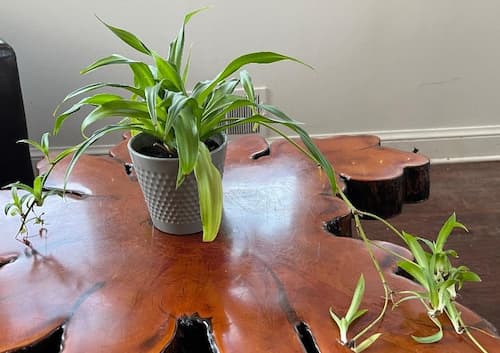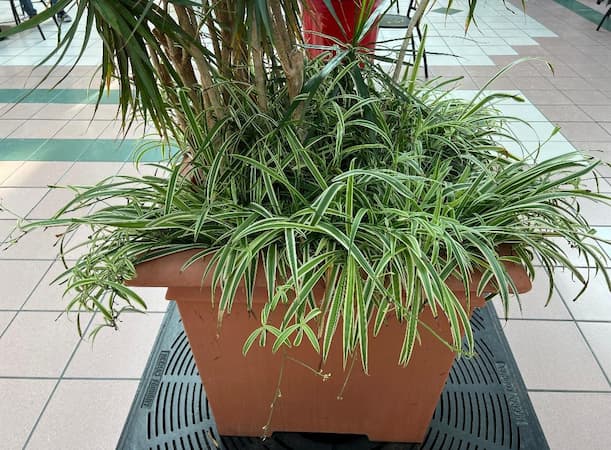How to Grow Spider Plants

About Spider Plants
Spider plants make great houseplants. They readily thrive in the conditions of your home or office. Native to tropical Africa and South Africa, they root easily and require little care. Perhaps that is why they are so popular! School teachers often use them in their curriculum. Growing and propagating baby spider plants is simple and easy. They are the perfect starter plant for tomorrow’s avid gardeners. So, let’s explore how to grow spider plants indoors or out.
The long-lived plants are best grown in containers and hanging baskets, where their shoots and tiny baby plants can hang down. However, as shown in the picture above, they look great on tables, too.
We normally think of spider plants in hanging baskets. But, there are other places to display them. We encourage you to be creative. In the picture above, the plant looks great sitting on a decorative table. And, in the picture below, it is used as a kind of ground cover in a large planter at a shopping mall.
Did You Know? These plants are good for your health. Spider plants are very effective at removing pollutants from the air and producing oxygen.
Spider Plant Specs
Plant Type: Perennial, evergreen
Soil Type: Loam, well-drained
Light Requirements: Bright, indirect
Plant Height: 18″ – 24″, not including the shoots and baby spiders
Flower Colors: White
Flowers Bloom: Regularly
Soil pH: 6.5 – 7.5
Hardiness Zone: 9 – 11
Toxicity: Non-toxic
Botanical Name: Chlorophytum comosum

Spider Plant Trivia
Become the subject matter expert on this great indoor houseplant.
- Fifteen spider plants can purify the air of the average house.
- Even people who do not have a green thumb can grow this easy-to-care-for plant.
- Growing them is proven to lower stress.
- High levels of oxygen they produce aids in a better sleep.
- Native Africans use the leaves and roots for medicine. Among the things it is used to treat are an antiseptic for wounds, dysentery, and stomachaches.
Propagating Baby Spider Plants
Mature plants send out shoots or stalks. At the end of these stalks, a tiny baby spider plant emerges. They are aptly called “spiderettes” or “plantlets”. Propagating baby spider plants is among the easyist plants to grow. Remove these baby spider plants and place the roots in water. Prune off the stem back to the base of the mother plant. After the roots have reached an inch or more, transplant them into a container with rich, well-drained potting soil.
So, what causes the plant to produce babies? When the plant becomes root-bound, it will begin to produce its cute little offspring. If you want your plant to produce babies, keep them in smaller containers.
Spider plants can also be propagated by seed. However, this is uncommon as rooting the is simply too easy.
Other Names: Ribbon Plant, Spider Ivy
Spider Plant Light Requirements
The plants grow best in bright, indirect lighting. They do well in low-light conditions. However, they benefit by being placed in a sunny window once or twice a week.
Too much light, especially direct sunlight scorches the leaves.
For large plants, rotate them every week or two so all of the leaves receive equal sunlight.
How to Grow Spider Plants - Care and Maintenance
Spider plants are easy to care for. Spider plants prefer a warm and humid environment. They like well-drained, rich potting soil. Make sure that the soil drains well, as they do not like wet soil. It is important to plant them in flowerpots with a hole in the bottom. If you overwater them, the excess water will drain out of the bottom of the flowerpot.
Established plants produce white flowers on a regular basis. Prune them back after the flower dies off.
Water the plants regularly after the top of the soil dries out. Mist the leaves occasionally, if the environment is dry.
Feed them with a liquid fertilizer once every four to six weeks, and they will grow well. Or, use houseplant fertilizer spikes. They have a time-release formula.
Spider plants do not like cold temperatures. Don’t leave the plants near a window on cold nights.
Prune back leaves as needed. The leaf tips of the plants will sometimes turn brown. This is often due to over-fertilizing or overwatering. Simply correct the problem and then snip off the brown leaves. Your plant will send out new replacement leaves.
As mentioned earlier, root-bound plants encourage the formation of spiderettes. However, the plant will eventually appear too large for the container. Repot the plant into a slightly larger flowerpot.
The plants ae not cold-hardy. Frost and freeze will kill the plants. If grown outdoors, bring them inside before nighttime temperatures Fall below 30° F.
Spider Plant Problems
When grown indoors, pest problems are infrequent. Aphids, spider mites, and whiteflies can be an occasional problem. Use neem oil or insecticidal soap.
Browning leaves are usually caused by too much water or fertilizer. It is also caused by too much direct sunlight or high slat levels in the soil.
Related Articles
For more information, see:
Please support our site. Shop for:
- rmmatthews100@hotmail.com
- 585-721-6528
- Rochester, NY
©1999-2024 GardenersNet.Com, All Rights Reserved

